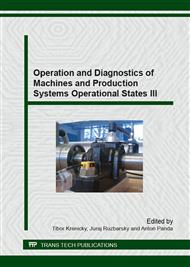[1]
T. Krenický, Implementation of Virtual Instrumentation for Machinery Monitoring, in: Scientific Papers: Operation and Diagnostics of Machines and Production Systems Operational States: Vol. 4, RAM-Verlag, Lüdenscheid, 2011, pp.5-8.
Google Scholar
[2]
J. Duplák T-vc dependence for cutting ceramic in standard ISO 3685, Manufacturing Engineering 9/4 (2010) 58-62.
Google Scholar
[3]
M. Kočiško, Workstation Verification by Means of Simulation Program Flexim, Scientific Bulletin 22 (2008) 245-248.
Google Scholar
[4]
M. Kovač, J. Peterka, Selected 5-axis Strategies for High-speed milling of Thin-walled Parts, Applied Mechanics and Materials 467 (2014) 466-469.
DOI: 10.4028/www.scientific.net/amm.467.466
Google Scholar
[5]
M. Kusnerova, J. Valicek, M. Harnicarova, Measurement of physical properties of polyurethane plaster, Gradevinar 66/10 (2014) 899-907.
Google Scholar
[6]
Z. Marciniak, The design of stamping dies, Warsaw, (2002).
Google Scholar
[7]
W. Muzykiewicz, J. Bednarczyk, A. Rekas, A. Lukaszka, Eversion of pipe element flanges with rigid tools in static conditions and through electrodynamic pressing, Ores and Nonferrous Metals, R 47, 2002, pp.10-11.
Google Scholar
[8]
A. Panda, J. Duplák, Comparison of Theory and Practice in Analytical Expression of Cutting Tools Durability for Potential Use at Manufacturing of Bearings, Applied Mechanics and Materials 616 (2014) 300-307.
DOI: 10.4028/www.scientific.net/amm.616.300
Google Scholar
[9]
W.P. Romanowski, Guidance for cold metal forming, WNT, Warsaw, (1976).
Google Scholar
[10]
A. Rosová, M. Balog, Ž. Šimeková, The use of the RFID in rail freight transport in the world as one of the new technologies of identification and communication, Acta Montanistica Slovaca 18/1 (2013) 26-32.
Google Scholar
[11]
D. Stančeková, A. Czán, M. Derbas, Investigation of defects in forging tools by nondestructive detection method, in: Proc. of METAL 2013 - 22nd International Conference on Metallurgy and Materials, Brno, Czech Republic; Tanger, Ostrava, 2013, pp.485-490.
Google Scholar


